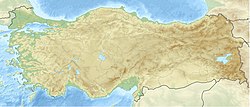2004 Doğubayazıt earthquake
You can help expand this article with text translated from the corresponding article in Turkish. (November 2020) Click [show] for important translation instructions.
|
| UTC time | 2004-07-01 22:30:09 |
|---|---|
| ISC event | 7366871 |
| USGS-ANSS | ComCat |
| Local date | 2 July 2004 |
| Local time | 01:30:09 |
| Magnitude | 5.1 Mw[1] |
| Depth | 5.0 km (3.1 mi)[1] |
| Epicenter | 39°45′58″N 43°58′44″E / 39.766°N 43.979°E |
| Fault | North Anatolian Fault |
| Areas affected | Turkey |
| Max. intensity | MMI VII (Very strong)[2] |
| Aftershocks | Around 80 |
| Casualties | 18 dead, 32 injured |
2004 Doğubayazıt earthquake was a 5.1 Mw[2] or 5.2 Mw[3] earthquake that rocked Doğubayazıt, Ağrı, Turkey on 2 July 2004 at 01.30 local time. Eighteen people were killed[4] and 32 were injured.[5]
The greatest damage was at Yığınçal village,[4] while Kutlubulak and Sağlıksuyu villages were also affected.[6] Kandilli Observatory stated that around 1000 buildings were damaged.[2] The earthquake was felt from Ağrı, Iğdır, Kars, and areas near Iran-Turkey border.[7] The intensity of the shock was reported as VII,[2] while the depth was reported as 5 km.[3][1] The earthquake happened during the local mountain pasture season where villagers were in the mountains, which prevented a higher number of casualties.[7] Various organizations sent relief to the area. Three ministers of Turkish government visited the area, Greece offered help and France sent messages of solidarity.[5]
Impact and damage
[edit]Although moderate in magnitude, the Doğubayazıt earthquake of 2 July 2004 had a devastating effect on local masonry construction. Striking at 01:30 local time with a Richter magnitude of 5.1 about 22 km north-north-west of Doğubayazıt, it caused 18 deaths, 25 injuries and damage to roughly 1,000 predominantly unreinforced stone buildings, many of which collapsed or were rendered uninhabitable.[8]
Post-event surveys showed that most failures resulted from traditional random-rubble walls bound with clay-rich or weak sand–cement mortars, often containing internal cavities that lowered shear strength. Roofs comprised successive layers of compacted earth atop wooden logs—a practice intended to prevent leaks—which greatly increased mass and lateral inertia during shaking. Rotting timber supports further undermined roof stability. Common damage patterns included flexural cracks across wall faces, corner separations of 1–5 cm, and fracturing around window openings. Only a few buildings, erected with better materials and workmanship, withstood the ground motions. Owners were subsequently urged to replace vulnerable dwellings with new construction conforming to Turkish seismic codes.[8]
See also
[edit]References
[edit]- ^ a b c "M 5.1 – eastern Turkey". United States Geological Survey. 1 July 2004. Retrieved 8 October 2019.
- ^ a b c d "Türki̇ye'de 1900 – 2004 Yillari Arasinda Can Kaybi Ve Hasara Neden Olmuş ÖNemli̇ Depremler ( Ms > 5.0 )". Kandilli Rasathanesi. Retrieved 31 January 2011.
- ^ a b Tapan, Mucip; Özvan, Ali; Şengül, M. Alper. "2 Temmuz 2004 Doğubayazit Depremi Yer – Yapi Ilişkisi Ve Yaşanan Kayiplar" (PDF). Kocaeli 2005 Deprem Sempozyumu. Archived from the original (PDF) on 10 November 2012. Retrieved 31 January 2011.
- ^ a b "Doğubeyazıt'ta Deprem: 18 ÖLü". Hürriyet. 2 July 2004. Retrieved 31 January 2011.
- ^ a b Yılmaz, Mükerrem; Kalkan, Ekrem; Yarbaşı, Necmi; Aksoy, Gökşin, "Doğu Anadolu Bölgesi'nde 2002-2004 Yıllarında Meydana Gelen Depremlere Ait Artçı Depremlerin İstatistiksel Çözümlemesi" (PDF), Kocaeli 2005 Deprem Sempozyumu, archived from the original (PDF) on 10 November 2012, retrieved 1 February 2011
- ^ "Ağrı'da Deprem: 18 Ölü". VOA Türkçe. 2 July 2004. Archived from the original on 25 October 2011. Retrieved 31 January 2011.
- ^ a b "Doğubeyazıt'ta 18 can kaybı". Radikal. 3 July 2004. Archived from the original on 1 December 2004. Retrieved 31 January 2011.
- ^ a b Bayraktar, Alemdar; CoŞkun, Nart; Yalçin, Ali (2007). "Damages of masonry buildings during the July 2, 2004 Doğubayazıt (Ağrı) earthquake in Turkey". Engineering Failure Analysis. 14 (1): 147–157. doi:10.1016/j.engfailanal.2005.11.011.

